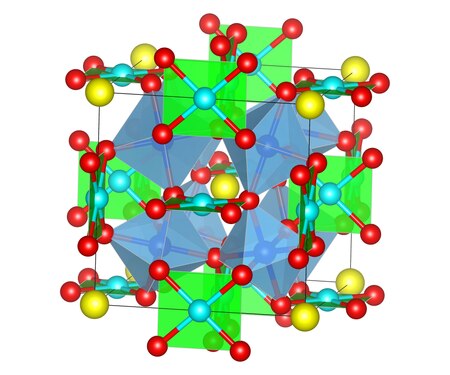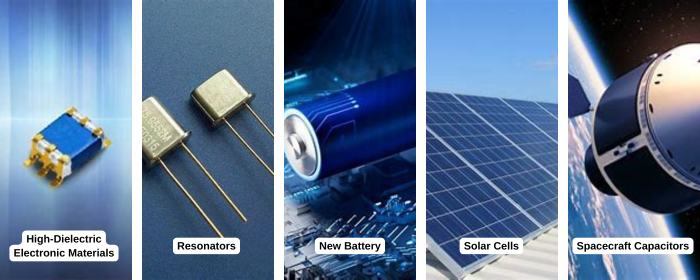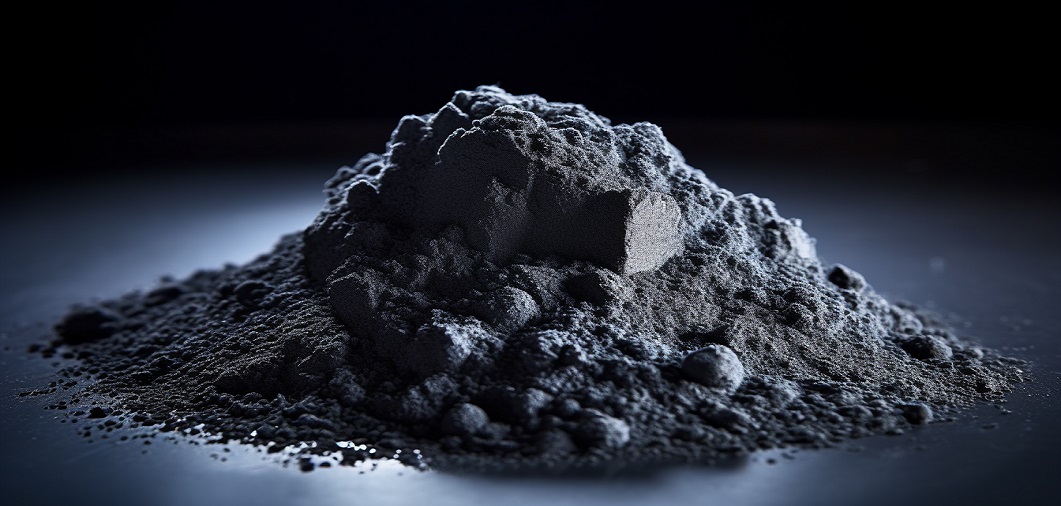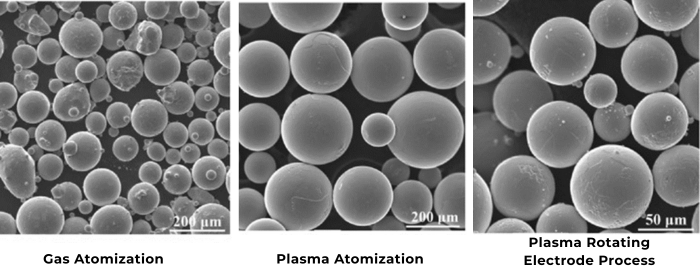

Calcium Copper Titanate, or CCTO, is a perovskite cubic crystal with outstanding combined properties. This makes it widely used in advanced fields like high-density energy storage, thin-film devices (such as MEMS and GB-DRAM), and high-dielectric capacitors.

Fig 1. Calcium Copper Titanate Structure
Calcium Copper Titanate is a dielectric material with unique properties that is noteworthy for its unusually high dielectric constant and low loss characteristics.
Dielectric materials are substances that can polarize in an electric field but do not conduct electricity. Their main characteristic is high resistivity, allowing them to isolate current while storing charge. Dielectrics are crucial for applications in capacitors, insulators, and energy storage devices, and they are widely used in electronics, power systems, and telecommunications.
Key Characteristics
● Dielectric Constant: This measures a material's ability to polarize in an electric field. A higher dielectric constant means the material can store more charge in a capacitor.
● Loss Factor: This measures how much energy is lost when the material is exposed to an electric field. A lower loss factor indicates less energy loss during operation.
● Breakdown Voltage: This is the maximum electric field strength the material can withstand before it loses its insulating properties and conducts electricity.
Compared to typical dielectric materials, Calcium Copper Titanate (CaCu₃Ti₄O₁₂, CCTO) offers many excellent properties that make it stand out.
First, CCTO has an unusually high dielectric constant, reaching 10⁴-10⁵ at room temperature, hundreds of times higher than standard dielectric materials like barium titanate. This high dielectric constant enables CCTO to store large amounts of charge in an electric field, making it suitable for high-energy-density capacitors and other electronic components.
Next, CCTO exhibits exceptional dielectric stability across a wide temperature range. Unlike other perovskite compounds with a dielectric constant above 1000, which often show ferroelectric and relaxation behaviors, CCTO remains stable without sensitivity to temperature changes. For example, barium titanate (BaTiO₃) materials experience a phase transition with temperature changes, impacting stability in applications. In contrast, CCTO, a non-ferroelectric oxide, maintains a stable high dielectric constant across 100-400K, with no phase transitions or Z-axis displacement.
Another noteworthy aspect of CCTO is its very low dielectric loss factor (tgδ), around 0.03, indicating minimal energy loss. This is crucial for devices like capacitors, as low energy loss improves efficiency and extends lifespan.
Moreover, unlike many materials that require doping to enhance dielectric properties, CCTO does not need doping to achieve a high dielectric constant. This simplifies the preparation process and reduces production costs. CCTO also does not require complex manufacturing processes, with a relatively low sintering temperature of around 1000℃ to 1100℃, which is uncommon among dielectric materials.
In summary, CCTO stands out for its:
● Exceptionally high dielectric constant
● Stable dielectric properties across a wide temperature range
● Low dielectric loss
● High dielectric constant without the need for doping
● Low sintering temperature

Fig 2. Calcium copper titanate dielectric constant and dynamic conductivity over 15 decades in frequency for various temperatures.[i]
Currently, Calcium Copper Titanate (CaCu₃Ti₄O₁₂ or CCTO) is mainly used in high-dielectric capacitors and energy storage devices. Its high dielectric constant and temperature stability make it highly suitable for miniaturized, high-energy-density capacitors. Additionally, CCTO’s low dielectric loss and good frequency response are valuable in microelectronic components, such as insulation layers in integrated circuits and thin-film capacitors.

Fig 3. Calcium Copper Titanate uses
Calcium Copper Titanate powder plays a significant role in high-tech and emerging technologies:
● High-Dielectric Electronic Materials: Due to its high dielectric performance, CCTO powder is commonly used in high-dielectric capacitors, suitable for high-density energy storage devices.
● Resonators: In high-frequency electronic devices, CCTO powder is used to manufacture resonators, enhancing device performance and stability.
● New Battery Types: Due to its excellent electrochemical properties, CCTO powder is also employed in developing new batteries, increasing energy density and cycle stability.
● Solar Cells: In the solar energy field, CCTO powder helps improve the conversion efficiency and stability of solar cells, promoting renewable energy development.
● Spacecraft Capacitors: Its outstanding temperature stability and mechanical properties make CCTO powder an important material in capacitors for spacecraft.
With improvements in manufacturing and reduced costs, Calcium Copper Titanate is expected to see broader use in energy storage, communications, and emerging electronic devices.
● High-Energy-Density Storage Devices: With a high dielectric constant and low loss, CCTO is suitable for high-energy-density capacitors and storage systems, especially in electric vehicles and smart grids.
● 5G and High-Frequency Communications: CCTO’s stable dielectric properties at high frequencies make it ideal for 5G and higher-frequency communication devices, including antennas and filters.
● Flexible Electronics and Wearable Devices: In thin-film form, CCTO can be used as a high-dielectric material in flexible electronics and wearable devices, enhancing performance and stability.
● New Sensors: CCTO's capacitance effect and stability offer potential in sensors, especially in high-precision medical and environmental monitoring applications.
Stanford Advanced Materials (SAM) provides high purity Calcium Copper Titanate Powder (CCTO) . If you are interested, please Get A Quote and learn more details.
In addition to CCTO, SAM also provides other high-quality dielectric materials such as:
1. What is Calcium Copper Titanate (CCTO)?
Calcium Copper Titanate, or CCTO, is a highly dielectric ceramic material that is extensively utilized in capacitors, energy storage, and electronics.
2. What are the key properties of CCTO?
CCTO possesses a giant dielectric constant, thermal stability, and low dielectric loss, making it a great option for high-performance electronic components.
3. Where is CCTO commonly used?
CCTO is used in capacitors, sensors, microwave devices, and energy storage units due to its improved electrical properties.
4. Why is CCTO better than other dielectric materials?
Compared to most materials, CCTO has good dielectric characteristics across a wide range of temperatures and can be relied upon in extreme conditions.
5. Is CCTO environmentally stable?
Yes, CCTO is chemically and thermally stable and hence offers long-term stability in most industrial and electronic applications.
6. Can CCTO be customized for specific applications?
Yes, CCTO can be made into specific compositions and structures for specific performance requirements in advanced electronics.
7. Where can I purchase high-quality CCTO materials?
Stanford Advanced Materials (SAM) supplies high-quality CCTO powders and ceramics for scientific research as well as industrial purposes.
[i] Kant, Ch & Rudolf, T. & Mayr, Franz & Krohns, Stephan & Lunkenheimer, Peter & Ebbinghaus, S. & Loidl, Alois. (2008). Broadband dielectric response of CaCu3Ti4O12: From dc to the electronic transition regime. Physical Review B. 77. 10.1103/PhysRevB.77.045131.







